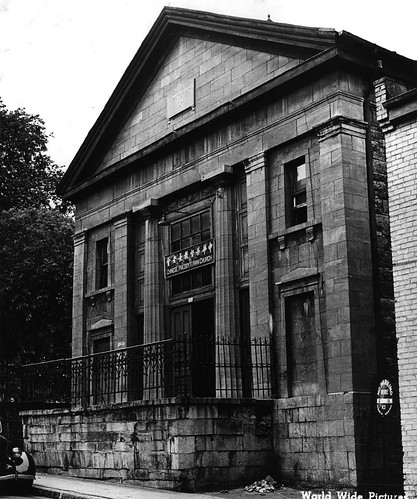Did you know that today’s Chinatown was once Jewish? From 1890 to 1920, thousands of Yiddish-speaking Jews came to Montreal from Eastern Europe and settled in the streets around St. Lawrence and Dorchester (now René Lévesque). In today’s Gazette, I take a close look at the evolution of this neighbourhood:
If Chinatown’s Jewish heritage isn’t obvious, it’s probably because it has been erased by time and redevelopment, swept away like Chenneville St. and its quietly imposing synagogue.
(…)
Located on a small street (now shortened and written as Cheneville) between St. Urbain and Jeanne Mance Sts., below Dorchester (now René Lévesque) Blvd. and above Craig (now St. Antoine) St., it was built in 1838 by Montreal’s oldest Jewish congregation, Shearith Israel.
In 1887, when Shearith Israel moved to a much larger home on Stanley St. – following the westward migration of Montreal’s older generations of Canadian-born, anglicized Jews – the synagogue was rented by Beth David, a congregation of Romanian immigrants who arrived in the late 19th century, part of a huge wave of Jewish immigrants from eastern Europe. Over the next three decades, the area around present-day Chinatown – with Bleury St. to the west, Sanguinet St. to the east, Craig to the south and Ontario St. to the north – became the heart of Jewish Montreal, a haven for Yiddish-speaking immigrants who established businesses, synagogues and many of the Jewish institutions that still exist.
Israel Medresh, a journalist for the Kanader Adler, a Yiddish-language daily newspaper, sketched a portrait of the neighbourhood in his 1947 book Montreal Foun Nekhtn, translated into English in 2000 as Montreal of Yesterday.
“The corner of St. Urbain and Dorchester was the very heart of the Jewish neighbourhood,” he wrote. “Nearby was Dufferin Park, then a ‘Jewish park’ where Jewish immigrants went to breathe the fresh air, meet their landslayt (compatriots), hear the latest news, look for work and read the newspapers.”
Just a few blocks from Dufferin Park stood seven synagogues, the first Young Men’s Hebrew Association and a number of important community and political organizations like the Baron de Hirsch Institute, the Hebrew Benevolent Society and the Jewish Labour Temple.
At its peak in the 1910s, Yiddish-language cultural life flourished in this downtown neighbourhood, with two bookstores on the Main, the newly-founded Jewish People’s Library (the predecessor to the present-day Jewish Public Library) and a regular programming of socialist and Zionist lectures and Yiddish theatre at the Monument National.
On Chenneville Street, about half of all residents were Jewish between 1900 and 1915. At the same time, the Chinese community was growing, and the first Chinese families moved onto Chenneville in 1914. Arthur Lee, who would grow up to become a fortune-cookie mogul and philanthropist, was born there in 1916. Nearby, the Chinese Masonic Temple opened in 1908 and it wasn’t uncommon for Chinese Nationalists to parade through the neighbourhood’s streets.
In the 1920s and 30s, as the centre of Jewish gravity in Montreal shifted north, beyond Pine Avenue and into Mile End and Outremont, Chinatown began to emerge in earnest. Beth David left the Chenneville St. synagogue in 1929; after a decade of decrepitude, it was bought by a Chinese Christian congregation and converted into the Chinese Presbyterian Church.
Virtually no traces of the old Jewish neighbourhood remain today. Chenneville St. and its synagogue were destroyed in 1979 for the construction of the Guy Favreau complex, which was one of several megaprojects—the others being the Desjardins complex, the Palais des congrès and the Ville-Marie Expressway—that did away with huge chunks of the neighbourhood in the 1970s.
Top photo: Chenneville St. synagogue around 1940, when it became a Chinese church. Bottom photo: Yiddish pamphlet from the 1930s proposing to turn the former synagogue into a Jewish museum and archives. Both photos courtesy of the Canadian Jewish Congress.


7 comments
what was it actually that drove the Jewish community “up north”? does anybody know?
There are a few different reasons:
– The quality of housing was generally higher in the north, since it was newer and apartments were more spacious.
– The garment trade was also expanding along St. Laurent above Sherbrooke, so many of the Jews who worked in the factories settled nearby.
– By the 1920s, there were significant development pressures in the downtown area, which forced many Jewish institutions to the north where they could find cheaper and more abundant space.
The move north in the 1920s and 30s was followed by another shift westward in the 40s and 50s, from Mile End and Outremont towards Snowdon, Hampstead and Côte St. Luc.
There’s a synagogue in Toronto’s Chinatown as well.
Fascinating.
I think its very funny that the chinese quarter was once jewish- Im happy to learn new things,thank you
It is written above that the synagogue was demolished in 1979 for the construction of Place Guy Favreau, that is not true. We arrived in Canada in 1958 and I attended kindergarten at the Chinese Presbyterian Church on Chenneville (at the very same spot. I remember the building was constructed of little red bricks and was modern and included a gymnasium on the north side, and I also remember a corner stone showing the year 1949 (before my time). I am thinking that perhaps the Chinese Prebyterian congregation purchased the old synagogue building and used it for a few years before demolishing it in 1949 to make way for the new building (the one I attended kindergarten in).
The chronology of dates as I understand your article is:
1)
built in 1838 by Montreal’s oldest Jewish congregation, Shearith Israel.
2) rented by Beth David in 1887; 3) Beth David left the Chenneville St. synagogue in 1929; 4) became a Chinese church around 1940.
My grandparents got married in Beth David in 1933 so it clearly wasn’t in this building. Do you know where Beth David rented from or bought next?